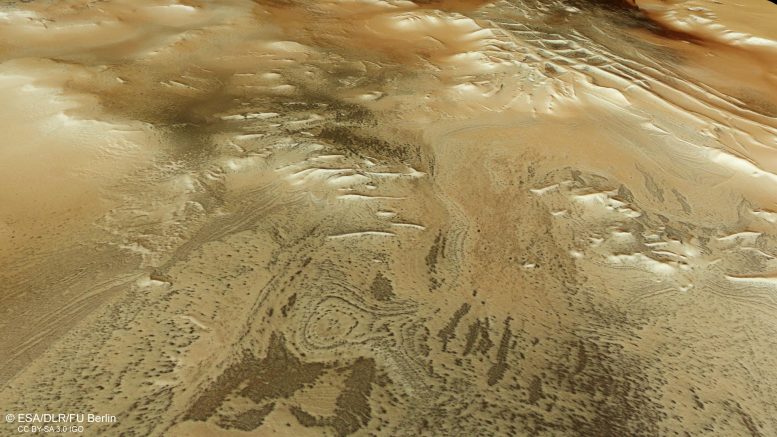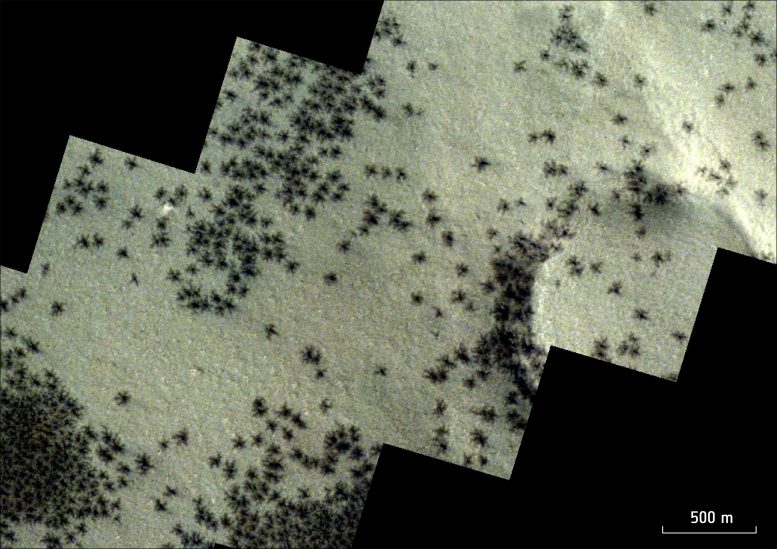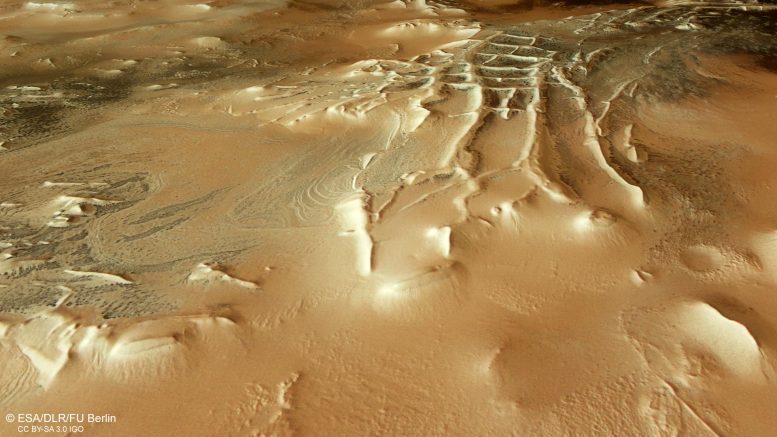
The dark spots in this image from ESA's Mars Express are the telltale signs of 'spiders' scattered across Mars' south pole. These tiny features form when carbon dioxide gas heats up in sunlight and breaks up the overlying layers of ice, etching branching craters on the surface and pulling dark material to the surface to form dark spots.
Several such smudges can be seen within the dark area to the left of the frame, which sits on the outskirts of a part of Mars nicknamed Inca City. The reason for the name is clear, the linear, almost geometric network of ridges is reminiscent of Inca ruins.
Credit: ESA/DLR/FU Berlin
The European Space Agencys tuesday Express picked up traces of 'spiders' scattered across the South Pole of Mars.
Rather than being true spiders, these small, dark features form when spring sunlight hits layers of carbon dioxide deposited during the dark winter months. Sunlight causes the carbon dioxide ice at the base of the layer to turn into a gas, which then forms and breaks up the layers of ice above. Gas erupts freely in the Martian spring, dragging dark material to the surface as it goes and breaking up layers of ice up to a meter thick.

This slanted viewpoint has earned a section of Mars nicknamed the Inca City (formally known as Angustus Labyrinthus). The reason for this is no mystery, the linear network of ridges is reminiscent of Inca ruins. Traces of features known as 'spiders' can be seen; These small, dark features are formed when carbon dioxide gas is heated by sunlight, breaking up the overlying ice layers. Credit: ESA/DLR/FU Berlin
The escaping gas, rich in dark dust, rises up through cracks in the ice in the form of tall fountains or geysers, and falls back down to settle on the surface. It forms dark spots 45 m to 1 km across. The same process creates 'spider-shaped' patterns etched beneath the snow – so these dark spots are a telltale sign that spiders may be lurking beneath.
Another of ESA's Mars probes, the ExoMars Trace Gas Orbiter (TGO), has captured particularly vivid images of the spiders' tendril-like patterns (see below). The spiders captured by TGO are close to, but outside of, the area shown in this new Mars Express image. The Mars Express view shows black spots on the surface formed by escaping gas and material, while the TGO perspective captures spidery, web-like channels carved into the ice below.

This image shows features called 'spiders' near the south pole of Mars, as seen by the CaSSIS (Colour and Stereo Surface Imaging System) instrument on ESA's ExoMars Trace Gas Orbiter.
These features form when spring sunlight falls on layers of carbon dioxide deposited during the dark winter months. Sunlight warms and gasifies the carbon dioxide ice at the base of the layer, which then forms and breaks up the layers of overlying ice. The ejected gas travels through cracks in the ice in the form of dark dusty, tall fountains or geysers, then falls back down and settles on the surface, creating dark spots. The same process creates 'spider-shaped' patterns etched into the ice: the same specimens are shown here.
Credit: ESA/TGO/CaSSIS
The aforementioned dark spots can be seen throughout the Mars Express image, creeping across high mountains and vast plateaus. However, most can be seen as small dots in the dark area to the left, on the outskirts of a region of Mars nicknamed the Inca City. The reason for the name is no mystery, the linear, almost geometric network of ridges reminiscent of Inca ruins. An Inca city known as Angustus Labyrinth was discovered in 1972. NASAMariner 9 study.
This new view of Inca City and its hidden arachnid inhabitants was captured by Mars Express' high-resolution stereo camera. A version with labels is also available; Click on the image below to explore the region and learn more about the different features you can find here.

This tilted perspective shows a part of Mars known as the Inca City. The reason for this is no mystery, a linear, almost geometric network reminiscent of Inca ruins on ridges. Known as Angustus Labyrinthus, the Inca City was discovered in 1972 by NASA's Mariner 9 probe. Credit: ESA/DLR/FU Berlin
A mysterious appearance
We still don't know exactly how the Inca city came to be. Sand dunes may have turned into stone over time. Perhaps magma or sand-like material seeping through broken sheets of Martian rock. Or, the ridges may be 'eskers', twisting structures related to glaciers.
The 'walls' of the Inca city appear to trace part of a great circle 86 km in diameter. Therefore, scientists suspect that the 'city' sits in a large crater formed when a rock from space crashed into the planet's surface. The impact may have caused ripples in the surrounding plains, which were then filled by rising lava and eroded over time.

This color-coded topographical image shows a portion of the landscape at the south polar region of Mars. It contains an area nicknamed the Inca City (called Angustus Labyrinths), characterized by linear ridges reminiscent of Inca ruins and traces of small, dark features known as 'spiders'. Sunlight heats the carbon dioxide gas and breaks up the upper layers of ice.
The view was created from data collected by ESA's Mars Express on February 27, 2024, and is based on a digital topographic model of the region, from which the terrain's topography can be derived. Lower parts of the surface are shown in blues and purples, while higher parts are shown in whites and reds, as indicated by the scale in the upper right.
Credit: ESA/DLR/FU Berlin
Towards the middle of the image the landscape changes somewhat, with large circular and oval swirls creating a marble-like effect. This effect is thought to occur as strata deposits erode over time.
In the right-center of the frame are a few prominent steep-sided, flat ridges and hills that rise more than 1500 meters above the surrounding terrain. These form as soft material, eroded over time by wind, water or ice flows, leaving the hard material that forms these mountains.
To the right (north) the land is heavily covered with fine, light-colored dust. A few signs of spiders can be found scattered across the plateaus here, lurking among the various ravines and troughs.

This stereoscopic image shows the region near the south pole of Mars in 3D. The area contains traces of Angustus Labyrinthus (a region on Mars nicknamed the 'City of the Incas' due to its linear ridges) and dark features known as 'spiders'. It was created from data taken on February 27, 2024 by the High Resolution Stereo Camera (HRSC) on board ESA's Mars Express orbiter. Anaglyph provides a three-dimensional display when viewed using red-green or red-blue glasses. Credit: ESA/DLR/FU Berlin
Exploring Mars
Mars Express has revealed a great deal about Mars over the past two decades. The orbiter will image the surface of Mars, map its minerals, study the composition and circulation of its atmosphere, probe beneath its crust, and study the Martian environment.
The spacecraft's HRSC showed us everything Wind-carved ridges and troughs Sinkholes in the flanks of giant volcanoes impact craters, tectonic faults, river channels, and ancient lava pools. This mission has yielded immense results over its lifetime, creating a more complete and accurate understanding of our planetary neighbors than ever before.